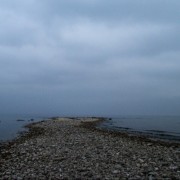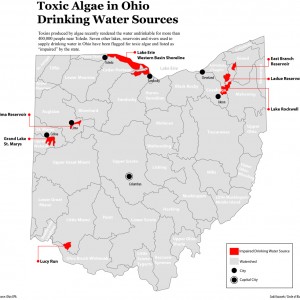Infographic: Toxic Algae in Ohio Drinking Water Sources
Algae toxins have been found in seven lakes, reservoirs, and rivers that supply drinking water to 1 million people.

Seven lakes, reservoirs, and rivers that supply drinking water to approximately 1 million people in Ohio have repeatedly exceeded safe levels of a toxin that can cause sickness and liver damage, according to a state water-quality report. It is important to note that the toxins — produced by algae — were found in the water supplies before they were treated and used for drinking water. After being treated, the water from these sources was within safety limits.
However, concentrations of the toxin were high enough after treatment in the Toledo area as to render the water undrinkable for more than 400,000 people in August 2014.
The findings about the growing threat to Ohio’s drinking water safety were contained in a biennial assessment of water quality that was conducted by the Ohio Environmental Protection Agency. The assessment was released in February but attracted little attention until August 2, when Toledo issued a “Do Not Drink” advisory due to high levels of algae toxins in its treated water.
The assessment included algae toxins for the first time this year and listed the following drinking water sources as “impaired,” meaning that levels of toxins were higher than the state’s threshold for safe drinking water on at least two separate occasions within five years.*
- Lake Erie Western Basin Shoreline — including Maumee Bay and Sandusky Bay [Toledo, Oregon, Ottawa County, Sandusky]
- Lima Reservoir—Ottawa River [Lima]
- East Branch Reservoir—East Branch Cuyahoga River [Akron]
- Ladue Reservoir—Bridge Creek [Akron]
- Lake Rockwell—Cuyahoga River [Akron]
- Lucy Run—East Fork Little Miami River [Clermont County]
- Grand Lake St. Mary’s [Celina]
*The state safety threshold for the algae toxin, microcystin, is 1 microgram of toxin per one liter of water, or 1 part per billion (ppb).
A news correspondent for Circle of Blue based out of Hawaii. She writes The Stream, Circle of Blue’s daily digest of international water news trends. Her interests include food security, ecology and the Great Lakes.
Contact Codi Kozacek









Leave a Reply
Want to join the discussion?Feel free to contribute!